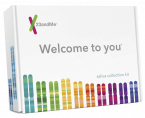Genealogy Sites - 23andMe
Overview
23andMe was founded in San Francisco in 2006 by three individuals – Linda Avey, Paul Cusenza and Anne Wojicicki – to offer genetic testing and interpretation to people. The company’s name was derived from the 23 pairs of chromosomes that are in a diploid human cell.
The founders received tech industry backing at an early stage, with Google investing $3.9 million (Anne Wojcicki and Google co-founder Sergev Brin being married at the time). In 2007 23andMe became the first company to begin offering autosomal DNA testing for ancestry, which all other major companies now use. Its saliva-based direct-to-consumer genetic testing business was named “Invention of the Year” by Time in 2008.
Subsequent history was a bit checkered. In 2013, because of the company’s aggressive marketing of its DNA as a health service, the US Food & Drug Administration (FDA) issued a public warning to 23andMe. Lessons were learnt and 23andMe is now on good terms with the FDA.
23andMe’s financial status was not materially effected by this incident and the company was able to raise some $800 million over the next seven years to fund expansion. The company has expanded the genealogical side of its DNA-testing business.
Still, 23andMe has remained focused on being a leader in using genetic information to improve public health. More recently, the company has been leveraging data from their genetic tests in order to conduct research on coronavirus. They want to determine which groups of people need to be more cautious while COVID-19 is around.
In 2021 23andMe merged with Richard Branson’s VG Acquisition Corp, in a $3.5 billion transaction. The combined company was renamed 23andMe Holding Co. and began trading on the NASDAQ stock exchange.
DNA Testing

23andMe, a pioneer in DNA testing, today has about 12 million users. It offers a comprehensive analysis of your ancestry, ethnicity, health traits, carrier status, wellness reports, and genetic relatives.
The ancestry component contains five reports:
- Composition (a basic breakdown of your genetic ancestry)
- Maternal haplogroup report (mtDNA)
- Paternal haplogroup report (Y-DNA)
- Neanderthal ancestry report
- DNA relatives (a list of people who have similar DNA – possible relatives, etc)
For male testers, 23andMe provides migration paths for both maternal and paternal lineages.
You can also opt for a health upgrade that gives you more insights into your health risks and predispositions. The company provides disease risk and health condition information, such as carrier status for genetic diseases, genetic risk of cancer, type 2 diabetes, Alzheimer’s disease, and many other conditions. And there are also are simple genetic trait reports like hair color and taste preferences. The health-related findings, it should be stressed, is not guaranteed to be 100% accurate.
23andMe’s service costs from $99 to $199. The higher price would add information on potential health indicators in your DNA.
How Does 23andMe Compare?
Ancestry DNA and 23andMe are the two leading DNA-testing sites.
Ancestry’s ethnicity tracing is much more detailed. And Ancestry does come out better in the presentation of its test results. Still, although 23andMe’s DNA database may be smaller than Ancestry’s, its DNA results have at times been comparable; as has the quality if not the quantity of matches it comes up with.
23andMe does offer matrilineal/patrilineal testing in its standard package, in addition to autosomal, which Ancestry does not. For many years 23andMe did not have a tree-building feature for DNA matched relatives. That was lost when their collaboration with MyHeritage ended. But a new Family Tree Builder has recently been introduced.
23andMe remains ahead of AncestryDNA on the health care front. For example they provide over forty different carrier status reports, as well as a number of other conditions such as Alzheimer’s disease, Parkinson’s disease, and Crohn’s disease. None of these health conditions are covered by the Ancestry Health tests.
And they probably have a more polished set design. This makes navigating the myriad charts, reports and explanatory documents easier than is the case with competitors’ sites.
Alternative Views
Some alternative views of 23andMe by Family History Fanatics can be seen in this video.
These are some comments by customers:
“23andMe seems a bit distant from its customers. 23andMe provides a fair amount of generalized information, and some, but not much, personally detailed information. For a DNA test, I expected more; maybe I am just too naive about what can be accomplished with spit.”
“This is a great company with reasonable prices for their services. They also do testing which you can qualify for at times. Right now I’m waiting on genetic testing results for a study I qualified for about Bi-polar. They are going to send me the results for what diseases I’m more likely to develop and my genetic make-up which is great because I’m adopted and have no family history to go on.”
“I had just gotten home from the gym when I opened the email from 23andMe, saying a report was ready for me to read. That click changed my life forever: To my utter shock, the results showed that I have a mutation in a gene called BRCA1, which puts me at a huge risk of developing breast and ovarian cancer. I broke into tears.
23andMe says its mission is to empower users with information, and I did feel empowered. If I hadn’t taken the at-home test, I likely would not have seen a doctor and a genetic counselor and had my genes tested. I am infinitely thankful that at-home genetics tests are cheap and available to people like me.”
Customer Rating: 67% (average of Trustpilot and Amazon ratings). 23andMe ranks 4th of the 6 DNA-testing sites reviewed here.
Click here for return to front page

